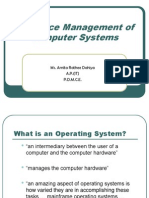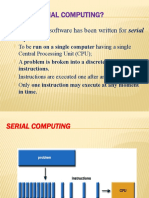Lecture 2 (Parallelism)
Uploaded by
hussiandavid26Lecture 2 (Parallelism)
Uploaded by
hussiandavid26University of Technology in Baghdad - Computer Engineering Department
Distributed Computer Systems
Issued by:
Dr. Ameer Mosa Thoeny Al-Sadi
lecture 2 (Parallelism)
Reference:
ADVANCED COMPUTER ARCHITECTURE AND PARALLEL PROCESSING
Outlines
• Some Elementary Concepts.
• Parallelism physical effect.
• Parallelism Reasons (Motivations).
• Challenges.
• Transparency in Distributed Systems.
SOME ELEMENTARY CONCEPTS
The Concept of Program: From the programmer’s perspective, roughly a
program is a well-defined set of instructions, written in some
programming language, with defined sets of inputs and outputs. From
the operating systems perspective, a program is an executable file stored
in a secondary memory. Software may consist of a single program or a
number of programs. However, a program does nothing unless its
instructions are executed by the processor. Thus a program is a passive
entity.
The Concept of Process: Informally, a process is a program in execution,
after the program has been loaded in the main memory. However, a
process is more than just a program code. A process has its own address
space, value of program counter, return addresses, temporary variables,
file handles, security attributes, threads, etc.
Process defined as a sequence of events (instructions, sending messages,
receiving messages).
Dr. Ameer Mosa Al-Sadi 1|Page
University of Technology in Baghdad - Computer Engineering Department
The Concept of Thread: Thread is a sequential flow of control within a
process. A process can contain one or more threads. Threads have their
own program counter and register values, but they are sharing the
memory space and other resources of the process. Each process starts
with a single thread. During the execution other threads may be created
as and when required.
Parallelism physical effect
Event p and q are independent, can’t have mutual effect because no one
from them can happen in case future of another.
Look in s1 see at first event p and then q.
Look in s3 will be change order in opposite.
Look in s2 can form that both events happen together.
Note: have never information about which event occur before.
For exact describe event in distributed system can’t use full (linear) ordering
(format), while for a lot of practical cases like this model is suitable.
Not each two events show ordering in time.
Not each distributed system give:
T(p) < T(q) v T(q) < T(p) v T(p)= T(q).
Models actually parallelism use partially ordering.
consists of a set together with a binary relation
indicating that, for certain pairs of elements in
the set, one of the elements precedes the other
in the ordering. The relation itself is called a
"partial order."
Dr. Ameer Mosa Al-Sadi 2|Page
University of Technology in Baghdad - Computer Engineering Department
Parallelism Reasons
Physical restriction.
Reliability, Accessibility.
-HA (High Availability)
Efficiency
-HPC (High Performance Computing)
Synchronization restriction.
Physical Restriction:
1. System, which is his spirit(matter)- “from nature” physically distributed, ex.
Sensor Network,
2. Sequence system here can’t use. Ex branches of organization.
3. No interest about performance, neither about reliability ,but about
capability execute with multiple inputs together. Ex. Map Reduce distributed
system.https://www.oreilly.com/library/view/distributed-computing-
in/9781787126992/5fef6ce5-20d7-4d7c-93eb-7e669d48c2b4.xhtml.
Dr. Ameer Mosa Al-Sadi 3|Page
University of Technology in Baghdad - Computer Engineering Department
4. System reflects natural distributed inputs, which are data and control
process. Ex. systolic array, Industrial Process Monitoring.
https://www.mdpi.com/2227-9717/5/3/35/htm
5. For example, // system control breaks when haven’t response for his input
immediately not until finish his assigned time.
6. Why Distributed database is used:
-Haven’t reason “Bear” data on one place.
-Branches of big organization.
Note:
Control system has wide technological processes:
• Especially remote sensor and actuators.
• Monitoring & control system from away (remote control)
• Multi input data flow must keeping execute together.
Dr. Ameer Mosa Al-Sadi 4|Page
University of Technology in Baghdad - Computer Engineering Department
Reliability:
1. Distribution system can be open additional redundant component for raising
all dependency.
2. Reduction components in distributed system have less effect on all
performance system than in system with unique resources.
3. Can increase quality service and efficiency, decrease response time but
functionality remains.
4. For example, about fail error (reduction)//
When dropout some DNS servers in reliable system.
Clients in network still have full access to server’s files.
Performance:
1. May be major reason examination and exploitation.
2. When one processor not provides adequate execution;
Time critical application (ex. Reactive system with strait time restriction,
weather, finances).
Time-consuming; big data or long loop.
More rising demand application than efficiency machine.
3. When solution on sequence architecture takes loss long time.
4. When we want solve complex problems.
5. Efficiency processes long rang rising (but for when?).
6. In past was efficiency supercomputing comparing with latest processors.
7. Always will be enough problem overlaps capability of executed nodes (grand
challenge).
Dr. Ameer Mosa Al-Sadi 5|Page
University of Technology in Baghdad - Computer Engineering Department
8. Most problems are naturally parallel.
9. Highest execute is can obtain from usable multiple processors at same time
(simultaneously).
Synchronies circuit:
What do processor between two edge clocks?
**** Wait***** (Clock restriction)
How get clock suddenly for all part chip?
****By specific clock buses**** (More Buses)
Asynchronies circuit:
Never clock:
1- Smaller needed (mobile equipment).
2- Less emitting (noise).
3- More execute (mean speed component).
4- Different work can execute simultaneously, different speeds.
5- Less dimension, more complex application.
Negotiable solution: mixed circuits.
Intel Pentium 4 has some parts asynchronous.
SUNFLEETzero- prototype asynchronous chips.
6- Better scalability.
Challenges (Differences from Sequential Computing)
Heterogeneity
Latency
Remote Memory Vs Local Memory
Synchronization
Concurrent interactions the shared resources.
Partial failure
Applications need to adapt gracefully in the face of partial failure.
Need for “openness”
Open standards: key interfaces in software and communication protocols
need to be standardized
Dr. Ameer Mosa Al-Sadi 6|Page
University of Technology in Baghdad - Computer Engineering Department
Security
Denial of service attacks
Mobile code
Scalability
Transparency
Transparency in Distributed Systems
Access transparency: enables local and remote resources to be accessed
using identical operations.
Location transparency: enables resources to be accessed without knowledge
of their physical or network location (for example, which building or IP
address).
Concurrency transparency: enables several processes to operate
concurrently using shared resources without interference between them.
Replication transparency: enables multiple instances of resources to be used
to increase reliability and performance without knowledge of the replicas by
users or application programmers.
Failure transparency: enables the concealment of faults, allowing users and
application programs to complete their tasks despite the failure of hardware
or software components.
Mobility transparency: allows the movement of resources and clients within
a system without affecting the operation of users or programs.
Performance transparency: allows the system to be reconfigured to improve
performance as loads vary.
Scaling transparency: allows the system and applications to expand in scale
without change to the system structure or the application algorithms.
Dr. Ameer Mosa Al-Sadi 7|Page
You might also like
- Final Cyber Security Lab Manual Practical 1 To Practical 1060% (5)Final Cyber Security Lab Manual Practical 1 To Practical 1094 pages
- CS439 CC 2 Parallel Distributed Systems[1]No ratings yetCS439 CC 2 Parallel Distributed Systems[1]37 pages
- Sardar Patel College of Engineering, Bakrol: Distributed Operating SystemNo ratings yetSardar Patel College of Engineering, Bakrol: Distributed Operating System16 pages
- Chapter 1n2 Characterization and Design GoalsNo ratings yetChapter 1n2 Characterization and Design Goals48 pages
- CS439-CC-2-Parallel Distributed SystemsNo ratings yetCS439-CC-2-Parallel Distributed Systems37 pages
- Flynn's Classification Divides Computers Into Four Major Groups That AreNo ratings yetFlynn's Classification Divides Computers Into Four Major Groups That Are44 pages
- Week1 - Parallel and Distributed Computing100% (1)Week1 - Parallel and Distributed Computing46 pages
- Chapter 1-Introduction To Distributed SystemsNo ratings yetChapter 1-Introduction To Distributed Systems59 pages
- 2-INTRODUCTION TO PDC - MOTIVATION - KEY CONCEPTS-03-Dec-2019Material - I - 03-Dec-2019 - Module - 1 PDFNo ratings yet2-INTRODUCTION TO PDC - MOTIVATION - KEY CONCEPTS-03-Dec-2019Material - I - 03-Dec-2019 - Module - 1 PDF63 pages
- CS326 Parallel and Distributed Computing: SPRING 2021 National University of Computer and Emerging SciencesNo ratings yetCS326 Parallel and Distributed Computing: SPRING 2021 National University of Computer and Emerging Sciences47 pages
- Introduction To Parallel Processing and Distributed SystemsNo ratings yetIntroduction To Parallel Processing and Distributed Systems15 pages
- 01 en Principles of Distributed SystemsNo ratings yet01 en Principles of Distributed Systems35 pages
- Lectures - Week 1 2 Introduction To Distributed ComputingNo ratings yetLectures - Week 1 2 Introduction To Distributed Computing65 pages
- Design of Parallel and Distributed Systems: Dr. Seemab LatifNo ratings yetDesign of Parallel and Distributed Systems: Dr. Seemab Latif36 pages
- DSECL ZG 522: Big Data Systems: Session 2: Parallel and Distributed SystemsNo ratings yetDSECL ZG 522: Big Data Systems: Session 2: Parallel and Distributed Systems58 pages
- Introduction To Distributed Systems: CSE 380 Computer Operating SystemsNo ratings yetIntroduction To Distributed Systems: CSE 380 Computer Operating Systems17 pages
- Lecture 1 - Fundamentals of Distributed SystemNo ratings yetLecture 1 - Fundamentals of Distributed System13 pages
- Distributed Systems Chapter 1-IntroductionNo ratings yetDistributed Systems Chapter 1-Introduction32 pages
- Distributed Systems: - CSE 380 - Lecture Note 13 - Insup LeeNo ratings yetDistributed Systems: - CSE 380 - Lecture Note 13 - Insup Lee24 pages
- What Is Serial Computing?: Traditionally, Software Has Been Written For Serial ComputationNo ratings yetWhat Is Serial Computing?: Traditionally, Software Has Been Written For Serial Computation22 pages
- Fortinac: Fortigate VPN Device IntegrationNo ratings yetFortinac: Fortigate VPN Device Integration45 pages
- How - Has - Technology - Affected - Day - To - Day - Life - in - The - Past - 25 - Years - Vanessa PagNo ratings yetHow - Has - Technology - Affected - Day - To - Day - Life - in - The - Past - 25 - Years - Vanessa Pag2 pages
- VST Installation and Management StrategiesNo ratings yetVST Installation and Management Strategies4 pages
- Automatic Transfer Switches: Power SystemsNo ratings yetAutomatic Transfer Switches: Power Systems13 pages
- Certificate of Candidacy For Mayor: Commission On ElectionsNo ratings yetCertificate of Candidacy For Mayor: Commission On Elections2 pages
- SGP15N60 SGW15N60: Fast IGBT in NPT-technologyNo ratings yetSGP15N60 SGW15N60: Fast IGBT in NPT-technology11 pages
- IMP Questions BCA 5th Semster MIS and E BusinessNo ratings yetIMP Questions BCA 5th Semster MIS and E Business2 pages

























































































